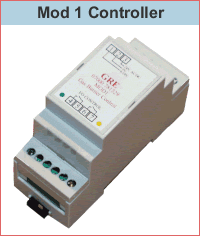Mod 1 Control:
Proportional Voltage Control Terminals 6 and 7:
The fan assisted flue induces a constant air movement through the burner bars and with a constantly lit ignition pilot, monitored by ionisation probe, the main flame can be switched on and off rapidly, no pre or post purge is necessary and the units frequency of switching is dictated by the control system.
The control includes a din rail mountable electronic control module, this unit can be sited anywhere convenient with connection to the burner by a pair of wires.
The control needs a 24V AC/DC power supply which is to be the same power supply as that used to generate the 0-10 control voltage. The unit switches the main burner on and off with reference to the control voltage in such a way that within a period the burner is held on for a time proportional to the control voltage.




- This gives a genuine 12-1 turndown ratio.
- Control all the way down to zero volts with 8% input at 0V.
- A room thermostat should be used if a limit to heat input is required. If the burner needs to be Shut off after 0V is reached terminals 1&2 should be made open circuit.
The thermal inertia of the heat exchanger ensures that the air off temperature does not vary more than 1 or 2° C at any steady control voltage.
All GRE modules can be retro fitted with these controls making the GRE module the most versatile small heat exchanger on the market.
GRE modules can be installed in multiples, most commonly in pairs, making any output available with the use of a single controller and relay kits to operate pairs of burners as master/slave units.
On/Off Control Terminals 4 and 5:
A Voltage Sensitive Relay is fitted which enables the burner to be positively switched off at 0.5 volts, should the control regime require this facility. The VSR is wired to open circuit burner terminals 3 and 5. For a burner shut down, these terminals are closed circuit again when the control voltage ramps up to 1.5V.
